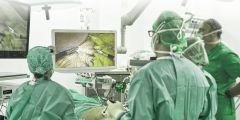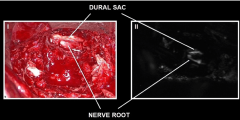FGS Publications Library
Our publications library is focused on collecting all of the most up-to-date research and information in the field of fluorescence guided surgery. We hope you find it to be a valuable resource!

A novel imaging technology to assess tissue oxygen saturation and its correlation with indocyanine green in the gastric conduit during thoracic esophagectomy
Abstract
Background
Anastomotic leakage in esophagectomy is a serious complication, and assessing blood perfusion in the conduit can help minimize this risk. Indocyanine green is the most widely used method to assess tissue blood flow; however, this technique has disadvantages. Evaluating tis…

Correlation Between Indocyanine Green Fluorescence Patterns and Grade of Differentiation of Hepatocellular Carcinoma: A Western Prospective Cohort Study
Abstract
Background. Most of the available evidence on the use of indocyanine green (ICG) fluorescence in clinical practice consists of articles published by surgeons of the Asian-Pacific area. We performed a prospective cohort study to assess the patterns of ICG fluorescence in Western hepatocell…

Special Issue of Surgery Fluorescence Guided Surgery
In February 2019 in Frankfurt, Germany, the Advisory Board of the International Society of Fluorescence-Guided Surgery (ISFGS) unanimously voted to conduct a series of Delphi surveys across multiple surgical fields as a first step towards drafting consensus guidelines. The first of these surveys…

Nerve autofluorescence under near-ultraviolet light: cutting-edge technology for intra-operative neural tissue visualization in 17 patients
Abstract
Background
Nerve visualization and the identification of other neural tissues during surgery is crucial for numerous reasons, including the prevention of iatrogenic nerve and neural structure injury and facilitation of nerve repair. However, current methods of intra-operative nerve detect…
Efficacy of Near-Infrared Fluorescence-Guided Hepatectomy for the Detection of Colorectal Liver Metastases: A Randomized Controlled Trial
Abstract
Background
The application of indocyanine green fluorescence–guided hepatectomy for liver metastases from colorectal cancer is in the preliminary stage of clinical practice; thus, its efficacy needs to be determined. This study compared the number of intrahepatic colorectal liver metastase…
Rapid intraoperative perfusion assessment of parathyroid adenomas with ICG using a wide-field portable hand-held fluorescence imaging system
Abstract
Background
Fluorescence angiography (FA) using indocyanine green dye (ICG) has recently been introduced for real-time identification of parathyroid adenomas. However, time to peak fluorescence has not yet been critically evaluated.
Methods
This was a retrospective review of parathyroidecto…
Clinical application of indocyanine green fluorescence imaging in laparoscopic lymph node dissection for intrahepatic cholangiocarcinoma: A pilot study (with video)
Abstract
Background
Intrahepatic cholangiocarcinoma is a highly lethal malignancy characterized by lymph node metastasis. This study aimed to evaluate the efficacy of indocyanine green fluorescence for visualization of lymphatic drainage and to assess its clinical application during laparoscopic ly…
Assessing the development status of intraoperative fluorescence imaging for perfusion assessments, using the IDEAL framework
Abstract
Objectives
Intraoperative fluorescence imaging is currently used in a variety of surgical fields for four main purposes: assessing tissue perfusion; identifying/localizing cancer; mapping lymphatic systems; and visualizing anatomy. To establish evidence-based guidance for research and prac…
Time to maximum indocyanine green fluorescence of gastric sentinel lymph nodes and feasibility of combined indocyanine green/sodium fluorescein gastric lymphography
Abstract
Purpose
Indocyanine green (ICG) and sodium fluorescein (SF) are fluorescent dyes used for sentinel lymph node mapping. In oncological gastric surgery, ICG lymphography has increased the number of resected lymph nodes. However, the optimal time to administer ICG is unclear, and both preoper…
Indocyanine green (ICG) fluorescent cholangiography during laparoscopic cholecystectomy using RUBINA™ technology: preliminary experience in two pediatric surgery centers
Abstract
Background
Recently, we reported the feasibility of indocyanine green (ICG) near-infrared fluorescence (NIRF) imaging to identify extrahepatic biliary anatomy during laparoscopic cholecystectomy (LC) in pediatric patients. This paper aimed to describe the use of a new technology, RUBINA™…
Near-infrared Fluorescence Imaging for Sentinel Lymph Node Identification in Melanoma Surgery
Abstract
Although less common than other types of skin cancers, melanoma is accountable for the majority of skin cancer-related deaths. The standard management for patients with clinically negative nodes includes a sentinel lymph node (SLN) biopsy, which is commonly performed using a combination of…
A Systematic Review of Concordance between Indocyanine Green and 99m Technetium Sentinel Lymph Node Identification in Melanoma
Stephanie L. Koonce*, Martin I. Newman University of Minnesota Medical School, USA
*Corresponding author: Stephanie L. Koonce, University of Minnesota Medical School, Cleveland Clinic Florida, 2950 Cleveland Clinic Blvd., Weston, USA Published: 23 Jun, 2017 Cite this article as: Koonce SL, Newman M…
Technical standardization of ICG near-infrared fluorescence (NIRF) laparoscopic partial nephrectomy for duplex kidney in pediatric patients
Abstract
Background
This study aimed to standardize the operative technique of indocyanine green (ICG) near-infrared fluorescence (NIRF) laparoscopic partial nephrectomy (LPN) and compare it with the standard technique.
Methods
In the last 4 years, we performed 22 LPN (14 right-sided, 8 left-sided)…
Quantitative fluorescence angiography aids novice and experienced surgeons in performing intestinal resection in well-perfused tissue
Abstract
Background
Anastomotic leakage (AL) after gastrointestinal resection is a devastating complication with huge consequences for the patient. As AL is associated with poor blood supply, tools for objective assessment of perfusion are in high demand. Indocyanine green angiography (ICG-FA) and…

Application of Indocyanine Green Fluorescence as an Adjuvant to Laparoscopic Ultrasound in Minimally Invasive Liver Resection
Abstract
Background: Indocyanine green (ICG) fluorescence imaging has been extensively used in a variety of applications in visceral surgery. In minimally invasive liver resections, the detection of small superficial hepatic lesions using an intravenous injection of ICG before surgery represen…
Nerve spectroscopy: understanding peripheral nerve autofluorescence through photodynamics
Methods: Samples from various human peripheral nerves were selected postoperatively. Nerve fibers were divided into three groups: Group A nerve fibers were washed with a physiologic solution; Group B nerve fibers were fixated with formaldehyde for 6 h first, and then washed with a physiologic solu…
Nerve autofluorescence in near-ultraviolet light markedly enhances nerve visualization in vivo
Methods: We exposed sciatic nerves within the posterior thigh in five 250-300 gm Wistar rats, then observed them at four different NUV intensity levels: 20%, 35%, 50%, and 100%. Brightness of fluorescence was measured by fluorescence spectroscopy, quantified as a fluorescence score using Image-J s…
Widespread anorectal lymphovascular networks and tissue drainage: analyses from submucosal india ink injection and indocyanine green fluorescence imaging
Methods
In this descriptive study, we performed microanatomical evaluations and intraoperative imaging analysis in a cadaver and patients with rectal cancer. Specimens with India ink injection were collected from a cadaver and six patients who underwent abdominoperineal resection. Intraoperative…
Does Near-infrared Fluorescent Cholangiography with Indocyanine Green Reduce Bile Duct Injuries and Conversions to Open Surgery During Laparoscopic or Robotic Cholecystectomy?
Methods
A thorough PubMed search was conducted to identify randomized clinical trials and nonrandomized clinical trials with ≥100 patients. Because all near-infrared fluorescent cholangiography studies were published since 2013, only studies without near-infrared fluorescent cholangiography publish…
Artificial Intelligence Indocyanine Green (ICG) Perfusion for Colorectal Cancer Intra-operative Tissue Classification
METHODS
Intraoperative white-light and NIR-fluorescence multispectral videos of primary colorectal tumours in patients undergoing diagnostic and therapeutic intervention were used for both AI model training and testing. These contained mucosal tumours subsequently determined as being benign or mali…
Commentary On: Indocyanine Green does not Decrease the Need for Bail-out Operation in an Acute Care Surgery Population
The authors of this publication are to be commended for conducting this retrospective study analyzing the impact of near infrared fluorescent cholangiography (NIFC) in patients undergoing laparoscopic cholecystectomy (LC) for symptomatic or complicated cholelithiasis in an acute care setting. In th…
Consensus Conference Statement on the general use of Near-infrared Fluorescence Imaging and Indocyanine Green Guided Surgery Results of a Modified Delphi Study
Background: In recent decades, the use of near-infrared light and fluores- cence-guidance during open and laparoscopic surgery has exponentially expanded across various clinical settings. However, tremendous variability exists in how it is performed.
Objective: In this first published survey of int…
Does Intraoperative Indocyanine Green Fluorescence Angiography Decrease the Incidence of Anastomotic Leakage in Colorectal Surgery? A Systematic Review and Meta-Analysis
ABSTRACT
Background
Colorectal anastomoses in patients with colorectal cancer carry a high risk of leakage. Indocyanine green fluorescence angiography (ICG-FA) is a new technique that allows surgeons to assess the blood perfusion of the anastomosis during operation. This meta-analysis aimed to eval…
The Impact of Indocyanine-green Fluorescence Angiography on Intraoperative Decision-making and Postoperative Outcome in Free Flap Surgery
ABSTRACT
Background
Reliable perfusion of the distal portions of free flaps is decisive for the reconstructive success. Indocyanine green near-infrared video angiography (ICG-NIR-VA) has been adopted for objective assessment of free flap tissue perfusion but is thus far not used on a routine basis…
Intraureteral Indocyanine Green Augments Ureteral Identification And Avoidance During Complex Robotic‐assisted Colorectal Surgery
ABSTRACT
Aim
Up to 10% of patients undergoing non‐urologic abdominopelvic operations suffer a ureteral injury. While preoperative ureteral stenting to facilitate ureteral identification is common, it does not reduce the incidence of intraoperative ureteral injury and is not without risk. As we cont…
Indocyanine Green Fluorescence Angiography and the Incidence of Anastomotic Leak after Colorectal Resection for Colorectal Cancer: A Meta-analysis
ABSTRACT
BACKGROUND
Anastomotic leak is a life-threatening complication of colorectal surgery. Recent studies showed that indocyanine green fluorescence angiography might be a method to prevent anastomotic leak.
OBJECTIVE
The purpose of this study was to investigate whether intraoperative indocyani…
Indocyanine Green Fluorescence Angiography Decreases the Risk of Colorectal Anastomotic Leakage: Systematic Review and Meta-analysis
Background
Anastomotic leakage after a colorectal resection results in devastating consequences for patients. Indocyanine green fluorescence angiography is a modality to visualize vascular perfusion at the anastomotic site and can help surgeons decide the viability of the anastomosis. We performed…
Use of Near-infrared Incisionless Fluorescent Cholangiography (Nifc) for Identification of the Anatomy in Biliary Surgery
Case Report
The following case study discusses a 37 years old, morbidly obese woman (BMI 43 Kg/m2) with impaired fasting glucose and no significant surgical history who presented to the clinic with a 3-month history of right upper quadrant (RUQ) abdominal pain, especially after meals. The physical…
Indocyanine Green Perfusion Assessment During Colonic Interposition for Graft Necrosis after Esophagectomy
Case Report
A 72-year-old Caucasian male with a past medical history of type 2 diabetes mellitus, hypertension, hyperlipidemia, myocardial infarction, gastric ulcer, gastroesophageal reflux disease (GERD), presented to the clinic complaining of lower chest discomfort and progressive dysphagia to bo…
Use of Near-infrared Incisionless Fluorescent Cholangiography (Nifc) for Identification of the Anatomy in Biliary Surgery
Case Report
The following case study discusses a 37 years old, morbidly obese woman (BMI 43 Kg/m2) with impaired fasting glucose and no significant surgical history who presented to the clinic with a 3-month history of right upper quadrant (RUQ) abdominal pain, especially after meals. The physical…
The use of Fluorescence Imaging in Colon Interposition for Esophageal Replacement: A Technical Note
Abstract
Every field of surgery has seen an explosion of new technologies aimed at improving surgical technique and reducing complications. The use of near-infrared (NIR) fluorescence to assess perfusion has been described in several surgical disciplines. NIR provides the surgeon with real-time per…
Indocyanine Green Use in Laparoscopic Cholecystectomy
ABSTRACT
Laparoscopic cholecystectomy is the surgical treatment of choice for benign diseases of the gallbladder because of the advantage of shorter postoperative hospital stays with faster recovery and cosmetic superiority. However, complications like iatrogenic vascular and bile duct injury are a…
A Novel Method for Near‐infrared Fluorescence Imaging of the Urethra During Perineal and Transanal Surgery: Demonstration in a Cadaveric Model
ABSTRACT
Aim
Transanal total mesorectal excision is a promising novel sphincter‐saving procedure for low rectal cancer. However, the transanal bottom‐up dissection is associated with increased rates of iatrogenic urethral injuries. Near‐infrared fluorescence (NIRF) imaging, given its deeper tissue…
Ureteric Localization with Indocyanine Green Fluorescence During Low Anterior Resection – A Video Vignette
Released: July 14th, 2020 08:25 PM
Website: HTTPS://ONLINELIBRARY.WILEY.COM/DOI/FULL/10.1111/CODI.15158
Intraoperative Near-infrared Imaging Can Identify Canine Mammary Tumors, a Spontaneously Occurring, Large Animal Model of Human Breast Cancer
ABSTRACT
Introduction
Current methods of intraoperative margin assessment in breast conserving surgery are impractical, unreliable, or time consuming. We hypothesized that intraoperative near-infrared (NIR) imaging with an FDA-approved NIR optical contrast agent could identify canine mammary tumors…
Evaluation Of Intraoperative Near-Infrared Fluorescence Visualization Of The Lung Tumor Margin With Indocyanine Green Inhalation
Question Can an intraoperative near-infrared fluorescence imaging technique be used to detect lung tumor margin via inhalation delivery of indocyanine green?
Findings In this diagnostic study, the fluorescent signal of inhaled indocyanine green was observed throughout healthy lung tissue but was…
Indocyanine Green Fluorescence Imaging To Predict Graft Survival After Orthotopic Liver Transplantation: A Pilot Study
ABSTRACT
Introduction: The incidence of primary non-function (PNF) after liver transplantation (LT) remains a major concern with the increasing use of marginal grafts. Indocyanine green (ICG) fluorescence is an imaging technique used in hepatobiliary surgery and LT. Because few early predictors…
Use Of Indocyanine Green For Intraoperative Ureteral Identification In Nonurologic Surgery
We report the use of indocyanine green (ICG) for ureteral identification during nonurologic surgery. Indocyanine green is a cyanine-based dye that can be injected intravenously to visualize vascularized structures with near-infrared (NIR) fluorescence. Other reports suggest that intraureteral IC…
A Study Investigating The Perfusion Of Colorectal Anastomoses Using Fluorescence Angiography: Results Of Flag Randomized Trial
Methods
A single center randomized trial was undertaken between 2018 and 2019. Those patients who underwent a stapled colorectal anastomosis were randomized 1:1 for ICG FA vs. visual clinical assessment of blood perfusion of the anastomosed colon and rectal stump (non‐ICG FA group). The primar…
Phase I Of Sgm-101 In Patients With Cancer Of The Colon, Rectum Or Pancreas
Introduction:
Surgery is the most important therapy for patients with cancer of the colon, rectum or pancreas. Complete resection, which is a crucial factor in the prognosis of a patient, is challenging as surgeons have to rely on visual appearance and palpation to discriminate between tumor and no…
Visualization And Quantification Of Anastomotic Perfusion In Colorectal Surgery Using Near-Infrared Fluorescence
ABSTRACT
Background
Anastomotic leakage (AL) is one of the most troublesome complications in colorectal surgery. Recently, near-infrared fluorescence (NIRF) imaging has been used intraoperatively to detect sentinel lymph nodes and visualize the blood supply at the region of interest (ROI)…
NCI Drug Dictionary Adds Definition For Fluorescent Antibody SGM-101
FLUORESCENT ANTIBODY SGM-101
A near infrared-emitting fluorochrome-labeled anti-carcinoembryonic antigen (ACE; anti-CEA) monoclonal antibody, with potential diagnostic imaging activity. Upon administration, the fluorescent antibody SGM-101 binds CEA-overexpressing cancer cells. Upon fluores…
SGM-101: An Innovative Near-Infrared Dye-Antibody Conjugate That Targets CEA For Fluorescence-Guided Surgery.
Abstract
PURPOSE:
Fluorescence-guided surgery (FGS) provides surgeons with new opportunities to improve real-time cancer nodule detection and tumor margin visualization. Currently, the most important challenge in this field is the development of fluorescent dyes that specifically target t…
Phase I Of SGM-101 In Patients With Cancer Of The Colon, Rectum Or Pancreas
Surgery is the most important therapy for patients with cancer of the colon, rectum or pancreas. Complete resection, which is a crucial factor in the prognosis of a patient, is challenging as surgeons have to rely on visual appearance and palpation to discriminate between tumor and normal…
Randomized Controlled Trial Comparing White Light With Near-Infrared Autofluorescence For Parathyroid Gland Identification During Total Thyroidectomy
Abstract
BACKGROUND:
Parathyroid glands are difficult to identify during total thyroidectomies, and accidental resection can lead to problematic postoperative hypocalcemia. Our main goals were to evaluate the effectiveness of using near-infrared light (NIRL) autofluorescence intraoperat…
Randomized Trial Of Near-Infrared Incisionless Fluorescent Cholangiography
Abstract
Background: Incisionless near-infrared fluorescent cholangiography (NIFC) is emerging as a promising tool to enhance the visualization of extrahepatic biliary structures during laparoscopic cholecystectomies.
Methods: We conducted a single-blind, randomized, 2-arm trial compari…
Transanal Total Mesorectal Excision For Rectal Cancer With Indocyanine Green Fluorescence Angiography
Abstract
BACKGROUND:
The aim of this study was to evaluate the impact of fluorescence angiography (FA) on any change in proximal resection margin and/or anastomotic leak (AL) following transanal total mesorectal excision (TaTME) for rectal cancer (RC).
METHODS:
This retrospective cohor…
Sensitivity And Specificity Of Indocyanine Green Near-Infrared Fluorescence Imaging In Detection Of Metastatic Lymph Nodes In Colorectal Cancer: Systematic Review And Meta-Analysis
Abstract
This review aimed to determine the overall sensitivity and specificity of indocyanine green (ICG) near-infrared (NIR) fluorescence in sentinel lymph node (SLN) detection in Colorectal cancer (CRC). A systematic search in electronic databases was conducted. Twelve studies in…
Indocyanine Green Fluorescence Imaging In Colorectal Surgery: Overview, Applications, And Future Directions.
Abstract
Indocyanine green fluorescence imaging is a surgical tool with increasing applications in colorectal surgery. This tool has received acceptance in various surgical disciplines as a potential method to enhance surgical field visualisation, improve lymph node retrieval, and…
Clinical Role Of Fluorescence Imaging In Colorectal Surgery - A Review
Abstract
Anastomotic leak (AL) after colorectal surgery is a devastating complication; decreased blood perfusion is an important risk factor. Surgeons rely on subjective measures to assess bowel perfusion. Fluorescence imaging (FI) with indocyanine green (ICG) provides a real-time…
Routine Use Of Fluorescent Incisionless Cholangiography As A New Imaging Modality During Laparoscopic Cholecystectomy
Abstract
BACKGROUND:
Intraoperative incisionless fluorescent cholangiography (IOIFC) has been described to identify extrahepatic biliary anatomy. Potential advantages of the routine use of intraoperative incisionless fluorescent cholangiography were evaluated in a consecutive ser…